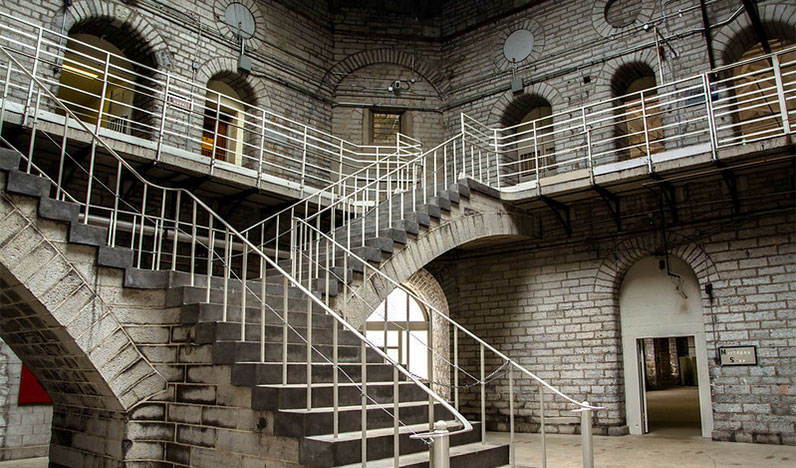Ticking time bomb
An excerpt from Catherine Fogarty’s account of the deadly 1971 riot at Kingston ‘Murder on the Inside’

Wednesday, April 14, 1971
Billy Knight sat quietly at one of the folding card tables at the back of the gymnasium. With his dark-brown jacket, khaki-coloured pants, striped shirt and black boots, he resembled every other guy in the room as he glanced at the well-worn playing cards held by his nicotine-stained fingers and then up at the clock behind the tattered basketball net. He was contemplating his next move.
Two portable televisions stood in the centre of the cinder-block gym. Some television show was on. It could have been Hawaii Five-O or The Mod Squad, two current favourites amongst the group. Or perhaps it was a rerun of Gunsmoke. It didn’t really matter because, with little else to do, the men were watching the screens impassively. This was a marked difference from the night before, during the fifth game of the quarter-final playoff series between the Toronto Maple Leafs and the New York Rangers. The series was tied two-all. Popular Leafs players including Dave Keon, Paul Henderson and Darryl Sittler were up against fellow Canadians Tim Horton and Mike Robitaille on the Rangers. The guys sitting in the gym lived for Hockey Night in Canada. It was the one thing that took them away from the deadening routine of prison life. But it was frustrating when games went into overtime and they couldn’t stay to watch. The televisions were turned off at precisely 10:30 p.m. no matter what. That was the rule.
In total, seventy-eight men from range two were gathered in the prison gym that night. William (Billy) Knight, prisoner #6622, was one of them. Everyone at KP, as the Kingston Penitentiary was nicknamed, knew Billy Knight. As the prison barber, he interacted with most of the inmates. Cutting hair was a trade he had picked up over the years while incarcerated. Strict adherence to personal grooming was one of the basic rules on the inside. Hair had to be short, and beards and moustaches were not permitted. When inmates came out of the “hole,” or solitary confinement, they were immediately handed off to Knight for the removal of any unruly hair growth. Fancying himself a fashionable guy despite his less than stylish surroundings, Billy’s hair was always meticulously groomed into a high 1940s pompadour, each strand of hair wet-combed to stand out in a high front wave above his forehead.
A well-liked, mouthy type, Knight never backed down from an argument. He was a strong advocate for exposing conditions within the prison and was always making impassioned speeches to anyone who would listen. If someone had a grievance with the administration, as many did, they knew to talk to Knight about it. He was a natural leader among the inmates. He was even writing a book, called The Walking Dead, an autobiography and exposé of prison life. He claimed it was going to revolutionize the system.
Knight was only twenty-eight, but he had already spent more of his life behind bars than on the outside. Being a small, wiry guy, Knight knew that in order to survive in a place like Kingston Pen he had to be smart. Make one bad move or piss off the wrong con and your life belonged to someone else.
As the evening of April 14 wore on, Knight continued playing cards. Scattered throughout the smoke-filled gymnasium were six other inmates he had recruited to help with his plan. Robert Adams and Allan Lafreniere sat at Billy’s table. Charles Saunders and Emanuel (Manny) Lester were at the next. And over by one of the television sets, Brian Dodge and Leo Barrieault appeared glued to what was on the screen, but in reality they were watching the guards.
That night, there were ten officers on duty in the main cell block. Three were in the gym and another was stationed in the gun cage that overlooked the entire room. Outside the gym, two guards were on the ground floor of the main dome, which contained a maze of metal stairways and circular galleries. Fanning out from the dome were eight cellblocks with more than six hundred cells. Four officers stood in the passageways around the perimeter of the dome. They were stationed at their respective posts in preparation for the inmates leaving the gymnasium to walk back to their cells.
The night keeper, or senior guard on call, was Edward (Ed) Barrett. At fifty-seven he had worn the uniform for close to thirty years, and it showed in the deep wrinkles and red veins on his face. Working alongside him were Douglas Dietrich and Donald Flynn, a loud, overly confident man. William Babcock was another hardline screw, and it was his job to maintain order and discipline in the gymnasium. Also working that night were Terrance (Terry) Decker, Douglas (dad) Dale and Joseph Vallier. Completing the group was young Kerry Bushell. At twenty-four, he was the rookie on staff and still in training. At Kingston Pen you learned on the job, and you learned quickly.
In 1971, Kingston Penitentiary had 359 employees, including administrators, support staff, medical personnel and guards. The relationship between the inmates and the guards at Kingston Pen was constantly strained, but in the weeks and months leading up to the night of April 14, 1971, the atmosphere inside the ancient stone prison had become downright volatile. The inmates were at war with the guards and the guards were at war with the prison administration. Backed by a powerful union, the Public Service Alliance, the guards wanted more money, more authority, more training and more protection. The administrators, in turn, were up against an inflexible bureaucracy called the Canadian Penitentiary Service. In one way or another, everyone was doing time.
Guards, for the most part, came from the same poor, working-class backgrounds as many of the convicts they watched over. They received little formal training and were expected to learn on the job. Fish screws (new guards) were quickly faced with the contradiction between their limited training at the staff college, which emphasized a new rehabilitation concept, and the harsh attitude of the old guard once they arrived at the prison. They had to either conform to the rigid stance of the experienced staff or be ostracized. New recruits learned to abide by the code or find a new career. You didn’t communicate with an inmate other than to tell him what to do, and you were never to show respect or kindness to any prisoner. To do so would lead to the instant label of con-lover.
Clinging to an archaic military system of strict order and discipline, seasoned guards revelled in punishing inmates for the smallest infraction. Shirts had to be buttoned and tucked at all times; hands had to be removed from pant pockets when walking; and there was no talking past 8 p.m. The penitentiary rules stated an inmate could speak with the officer in charge of him only in matters connected with his work. He had to approach the officer in a respectful manner, address him as Sir and stand at attention. Step out of line and you could lose hard-earned privileges or, worse, you went to the hole.
There was little pride or feeling of accomplishment associated with being a prison guard. It was the “occupation of last resort,” the job you took if you couldn’t get anything else. Poor public attitudes towards the many prisons in the Kingston area also contributed to a lack of respect for guards in the community. Guards did not wear uniforms out in public and their families kept to themselves in the city. They worked a lot of overtime because of constant staffing shortages, but they knew where to get a cold beer when their shift was done. The Portsmouth Tavern, or “the Ports,” in the adjoining village was the place you went to drink if you worked at KP.
The job of a prison guard was dangerous, tough work. New recruits were hard to find and even harder to keep once they got a taste of Kingston Pen. As a result, the prison was often severely understaffed. And on the night of April 14, 1971, that was a situation Billy Knight planned to take full advantage of.
This excerpt of Murder on the Inside: The True Story of the Deadly Riot at Kingston Penitentiary, published by Biblioasis, is © reprinted by permission. All rights reserved.


